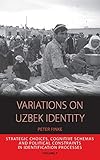Variations on Uzbek Identity : Strategic Choices, Cognitive Schemas and Political Constraints in Identification Processes / Peter Finke.
Material type: TextSeries: Integration and Conflict Studies ; 7Publisher: New York ; Oxford : Berghahn Books, [2014]Copyright date: ©2014Description: 1 online resource (288 p.)Content type:
TextSeries: Integration and Conflict Studies ; 7Publisher: New York ; Oxford : Berghahn Books, [2014]Copyright date: ©2014Description: 1 online resource (288 p.)Content type: - 9781782382386
- 9781782382393
- 305.894 325 23
- online - DeGruyter
| Item type | Current library | Call number | URL | Status | Notes | Barcode | |
|---|---|---|---|---|---|---|---|
 eBook
eBook
|
Biblioteca "Angelicum" Pont. Univ. S.Tommaso d'Aquino Nuvola online | online - DeGruyter (Browse shelf(Opens below)) | Online access | Not for loan (Accesso limitato) | Accesso per gli utenti autorizzati / Access for authorized users | (dgr)9781782382393 |
Frontmatter -- Contents -- Illustrations -- Preface -- Acknowledgements -- Introduction -- Chapter 1 A Historical Sketch of the Uzbeks: From Nomadic Conquerors to Post-socialist Farmers -- Chapter 2 A Central Asian Melting Pot: The Oasis of Bukhara -- Chapter 3 Desperation at the End of the World? The Oasis of Khorezm -- Chapter 4 Conflict Inevitable? The Ferghana Valley -- Chapter 5 Birthplace of a National Hero: The Oasis of Shahrisabz -- Conclusion -- Bibliography -- Index
restricted access online access with authorization star
http://purl.org/coar/access_right/c_16ec
Throughout its history the concept of “Uzbekness,” or more generally of a Turkic-speaking sedentary population, has continuously attracted members of other groups to join, as being Uzbek promises opportunities to enlarge ones social network. Accession is comparatively easy, as Uzbekness is grounded in a cultural model of territoriality, rather than genealogy, as the basis for social attachments. It acknowledges regional variation and the possibility of membership by voluntary decision. Therefore, the boundaries of being Uzbek vary almost by definition, incorporating elements of local languages, cultural patterns and social organization. This book combines an historical analysis with thorough ethnographic field research, looking at differences in the conceptualization of group boundaries and the social practices they entail. It does so by analysing decision-making processes by Uzbeks on the individual as well as cognitive level and the political configurations that surround them.
Mode of access: Internet via World Wide Web.
In English.
Description based on online resource; title from PDF title page (publisher's Web site, viewed 25. Jun 2024)


